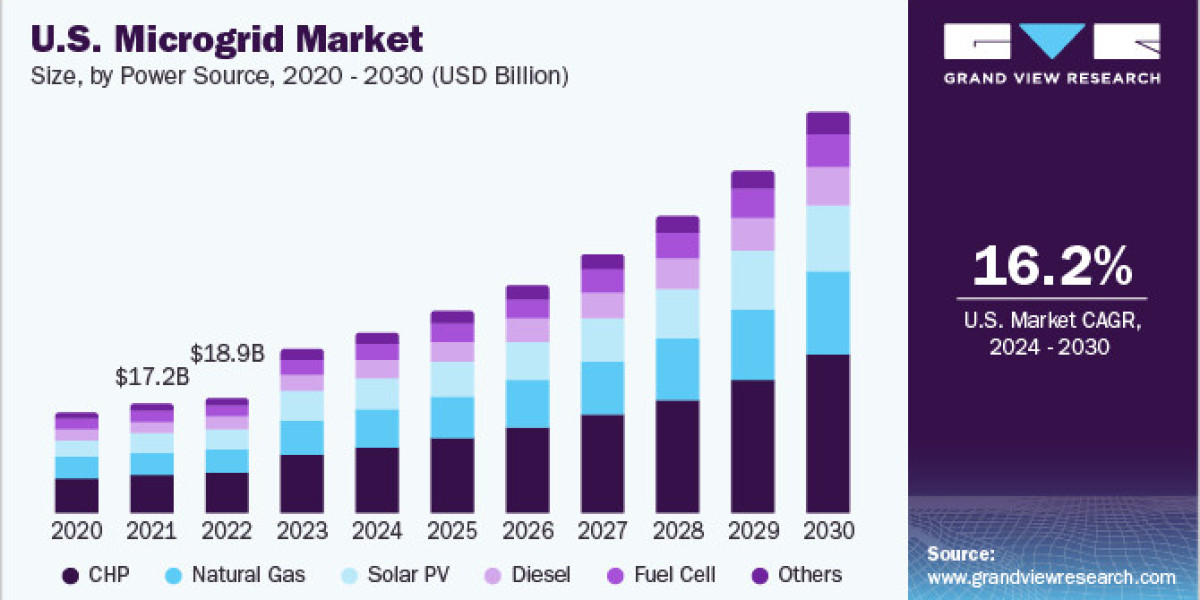The global microgrid market was valued at USD 76.88 billion in 2023 and is projected to grow at a compound annual growth rate (CAGR) of 17.1% from 2024 to 2030. This growth is driven by increasing power demand in developing countries such as Mexico, China, India, and Russia, spurred by expanding household and industrial sectors. A microgrid refers to a localized electrical system capable of operating in conjunction with or independently from traditional electric grids. The growing preference for localized, distributed power generation over large remote power plants is expected to significantly influence market growth by enhancing energy reliability, resiliency, and efficiency in cities, communities, and campuses.
Microgrids provide improved local resiliency and help stabilize regional electric grids, which are increasingly important as reliance on renewable energy resources grows. The manufacturing sector, in particular, has embraced captive power generation systems to reduce dependency on regional grids. This trend, along with rising awareness about renewable power generation through sources like wind, solar, and hydrogen, is expected to positively impact market expansion.
Gather more insights about the market drivers, restrains and growth of the Global Microgrid Market
In recent years, urbanization and population growth in emerging markets have led to increased government spending on infrastructure development, boosting power demand and, consequently, the microgrid market. Investments in innovative smart microgrid prototypes, such as those supported by the Galvin Energy Initiative, are also expected to open up new opportunities. Additionally, the U.S. and Canada’s emergence as leaders in shale gas production, driven by the adoption of hydraulic fracturing technology, is projected to further expand access to power sources for consumers.
Power Source Insights
The Combined Heat & Power (CHP) segment led the market, accounting for over 37% of global revenue in 2023. The growing shift from traditional Separate Heat & Power (SHP) systems to single-fuel energy generation is a major driver of growth in this segment. Fuel cells are also expected to see significant growth due to their ability to operate at high temperatures with minimal energy loss, expanding their use in the near future.
Developed countries like the U.S., Germany, the UK, and Japan are providing strong support for increasing power generation from solar energy, which will positively impact the market. Moreover, advancements in organic solar PV module technology are expected to open new growth avenues. However, the diesel power source segment is expected to see moderate growth due to stringent regulations limiting fossil fuel use. Despite these restrictions, the continued reliance on diesel power for electricity generation in manufacturing sectors across developed economies remains a favorable factor.
Product Insights
In 2023, the grid-connected microgrid segment dominated the market, comprising over 65% of the total revenue. The increasing popularity of smart grid-connected photovoltaic (PV) systems, which help reduce transmission losses while delivering electricity, is a key factor driving this segment. Companies like North Power Systems are already utilizing hybrid technologies, combining wind turbines with solar PV, diesel gensets, and other power sources for microgrid projects in regions such as Hawaii, Alaska, the Bahamas, and Antarctica.
Grid-connected microgrids are gaining popularity in rural and urban areas with limited or no access to the main grid. The growth of distributed energy resources, such as solar panels and energy storage systems, has fueled this trend. Communities are increasingly adopting microgrids to reduce their carbon footprints and enhance energy independence. Additionally, the defense sector is adopting microgrids to reduce reliance on conventional fuel sources. Remote microgrids are also playing a crucial role in providing electricity to isolated areas in developing countries.
Application Insights
In 2023, the education sector was the largest application segment, accounting for over 37% of global revenue. Increased government investments in improving educational infrastructure in rural areas, particularly in developing countries like China and India, are expected to boost the demand for microgrids. Additionally, the need for a reliable power supply to support lighting, HVAC systems, and electronic devices in hospitals, corporate offices, and retail outlets is anticipated to drive significant growth.
The commercial sector is also a major contributor to the microgrid market. Businesses are adopting microgrids to reduce their dependency on main grids and improve energy efficiency. Microgrids are also increasingly being used for backup power during outages, which is critical for facilities such as hospitals and data centers. In the defense sector, microgrids are used to power bases and remote installations, enhancing energy security and reducing dependence on traditional fuels in challenging environments.
Other key applications for microgrids include healthcare facilities and public infrastructure such as streetlights and traffic signals. In these settings, microgrids enhance energy efficiency, lower costs, and provide reliable backup power during outages. This broad application scope highlights the growing importance of microgrids across various sectors.
Order a free sample PDF of the Microgrid Market Intelligence Study, published by Grand View Research.








